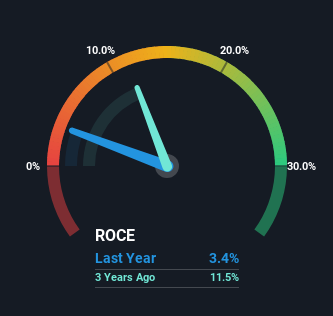- South Korea
- /
- Electrical
- /
- KOSDAQ:A054210
Capital Allocation Trends At Elentec (KOSDAQ:054210) Aren't Ideal
What are the early trends we should look for to identify a stock that could multiply in value over the long term? Amongst other things, we'll want to see two things; firstly, a growing return on capital employed (ROCE) and secondly, an expansion in the company's amount of capital employed. This shows us that it's a compounding machine, able to continually reinvest its earnings back into the business and generate higher returns. In light of that, when we looked at Elentec (KOSDAQ:054210) and its ROCE trend, we weren't exactly thrilled.
Return On Capital Employed (ROCE): What Is It?
If you haven't worked with ROCE before, it measures the 'return' (pre-tax profit) a company generates from capital employed in its business. To calculate this metric for Elentec, this is the formula:
Return on Capital Employed = Earnings Before Interest and Tax (EBIT) ÷ (Total Assets - Current Liabilities)
0.034 = ₩11b ÷ (₩539b - ₩207b) (Based on the trailing twelve months to June 2024).
So, Elentec has an ROCE of 3.4%. Ultimately, that's a low return and it under-performs the Electrical industry average of 8.3%.
View our latest analysis for Elentec

Historical performance is a great place to start when researching a stock so above you can see the gauge for Elentec's ROCE against it's prior returns. If you're interested in investigating Elentec's past further, check out this free graph covering Elentec's past earnings, revenue and cash flow.
What Does the ROCE Trend For Elentec Tell Us?
When we looked at the ROCE trend at Elentec, we didn't gain much confidence. Over the last five years, returns on capital have decreased to 3.4% from 12% five years ago. And considering revenue has dropped while employing more capital, we'd be cautious. This could mean that the business is losing its competitive advantage or market share, because while more money is being put into ventures, it's actually producing a lower return - "less bang for their buck" per se.
On a related note, Elentec has decreased its current liabilities to 38% of total assets. That could partly explain why the ROCE has dropped. Effectively this means their suppliers or short-term creditors are funding less of the business, which reduces some elements of risk. Since the business is basically funding more of its operations with it's own money, you could argue this has made the business less efficient at generating ROCE.
In Conclusion...
In summary, we're somewhat concerned by Elentec's diminishing returns on increasing amounts of capital. In spite of that, the stock has delivered a 17% return to shareholders who held over the last five years. Either way, we aren't huge fans of the current trends and so with that we think you might find better investments elsewhere.
If you want to know some of the risks facing Elentec we've found 3 warning signs (2 can't be ignored!) that you should be aware of before investing here.
While Elentec isn't earning the highest return, check out this free list of companies that are earning high returns on equity with solid balance sheets.
Valuation is complex, but we're here to simplify it.
Discover if Elentec might be undervalued or overvalued with our detailed analysis, featuring fair value estimates, potential risks, dividends, insider trades, and its financial condition.
Access Free AnalysisHave feedback on this article? Concerned about the content? Get in touch with us directly. Alternatively, email editorial-team (at) simplywallst.com.
This article by Simply Wall St is general in nature. We provide commentary based on historical data and analyst forecasts only using an unbiased methodology and our articles are not intended to be financial advice. It does not constitute a recommendation to buy or sell any stock, and does not take account of your objectives, or your financial situation. We aim to bring you long-term focused analysis driven by fundamental data. Note that our analysis may not factor in the latest price-sensitive company announcements or qualitative material. Simply Wall St has no position in any stocks mentioned.
About KOSDAQ:A054210
Elentec
Engages in the manufacture and sale of electronic and communication products in South Korea and internationally.
Undervalued with high growth potential.
Market Insights
Community Narratives




